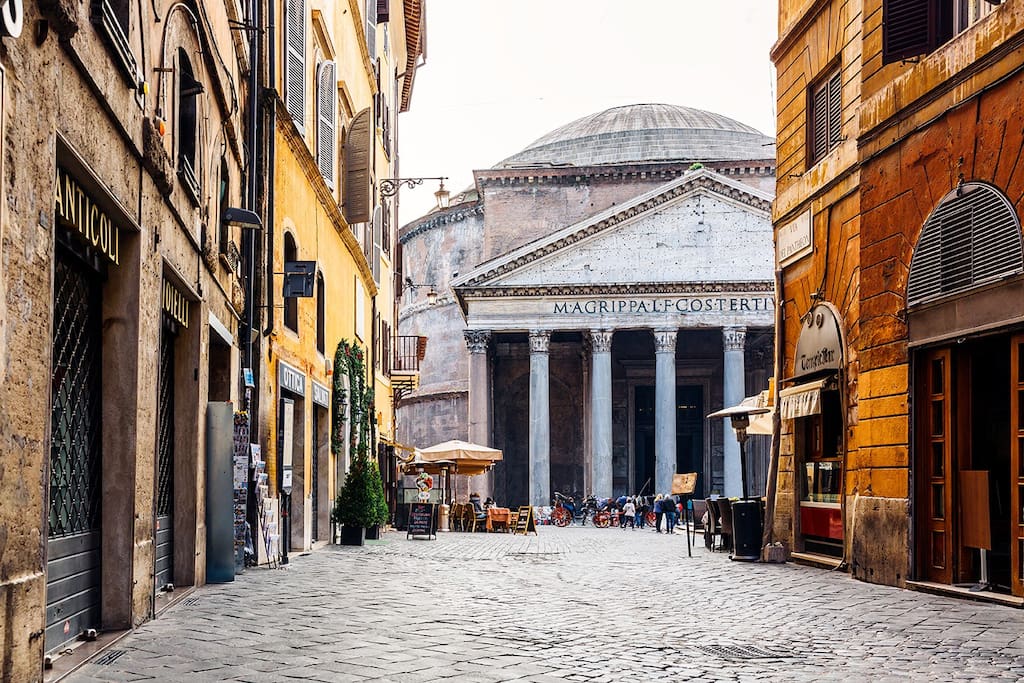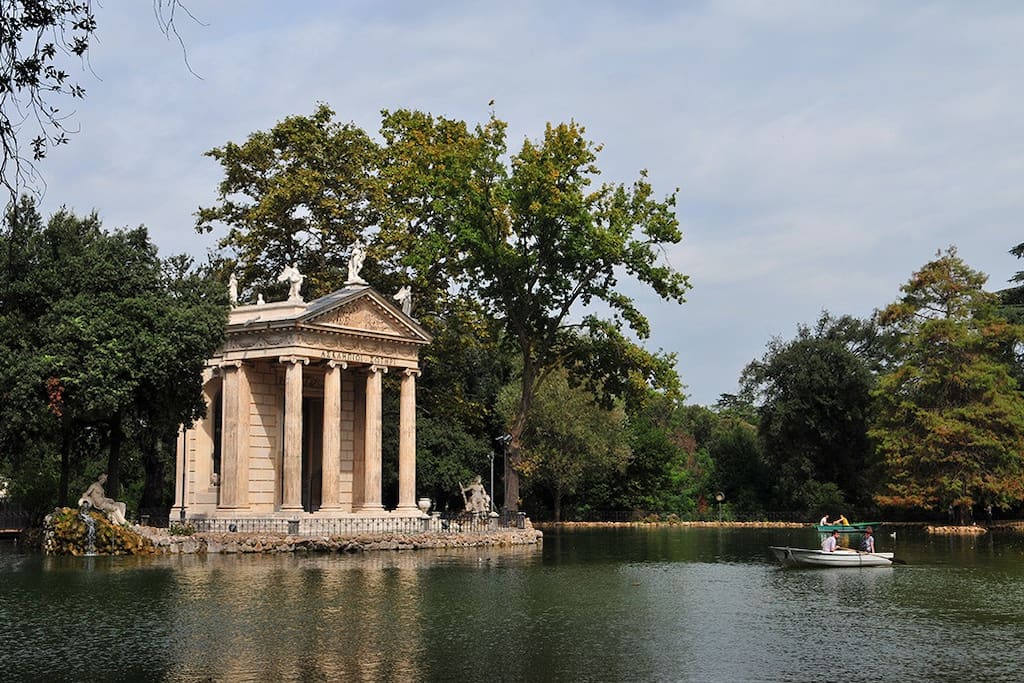Sightseeing
Piazza del Popolo is a large urban square in Rome. The name in modern Italian literally means "People's Square", but historically it derives from the poplars (populus in Latin, pioppo in Italian) after which the church of Santa Maria del Popolo, in the northeast corner of the piazza, takes its name.
The piazza lies inside the northern gate in the Aurelian Walls, once the Porta Flaminia of ancient Rome, and now called the Porta del Popolo. This was the starting point of the Via Flaminia, the road to Ariminum (modern-day Rimini) and the most important route to the north. At the same time, before the age of railroads, it was the traveller's first view of Rome upon arrival.
797 polecane przez mieszkańców
Plac Piazza del Popolo
Piazza del PopoloPiazza del Popolo is a large urban square in Rome. The name in modern Italian literally means "People's Square", but historically it derives from the poplars (populus in Latin, pioppo in Italian) after which the church of Santa Maria del Popolo, in the northeast corner of the piazza, takes its name.
The piazza lies inside the northern gate in the Aurelian Walls, once the Porta Flaminia of ancient Rome, and now called the Porta del Popolo. This was the starting point of the Via Flaminia, the road to Ariminum (modern-day Rimini) and the most important route to the north. At the same time, before the age of railroads, it was the traveller's first view of Rome upon arrival.
Vatican City Città del Vaticano officially Vatican City State or the State of Vatican City (Italian: Stato della Città del Vaticano; Latin: Status Civitatis Vaticanae), is a walled enclave within the city of Rome. With an area of approximately 44 hectares (110 acres), and a population of it is the smallest sovereign state in the world by both area and population.
It is an ecclesiastical or sacerdotal-monarchical state (a type of theocracy) ruled by the Bishop of Rome – the Pope. The highest state functionaries are all Catholic clergy of various national origins.
563 polecane przez mieszkańców
Watykan
Vatican City Città del Vaticano officially Vatican City State or the State of Vatican City (Italian: Stato della Città del Vaticano; Latin: Status Civitatis Vaticanae), is a walled enclave within the city of Rome. With an area of approximately 44 hectares (110 acres), and a population of it is the smallest sovereign state in the world by both area and population.
It is an ecclesiastical or sacerdotal-monarchical state (a type of theocracy) ruled by the Bishop of Rome – the Pope. The highest state functionaries are all Catholic clergy of various national origins.
Defined as a public space in the last years of 15th century, when the city market was transferred there from the Campidoglio, Piazza Navona was transformed into a highly significant example of Baroque Roman architecture and art during the pontificate of Innocent X, who reigned from 1644 until 1655, and whose family palace, the Palazzo Pamphili, faced the piazza. It features important sculptural and architectural creations: in the center stands the famous Fontana dei Quattro Fiumi or Fountain of the Four Rivers (1651) by Gian Lorenzo Bernini, topped by the Obelisk of Domitian, brought in pieces from the Circus of Maxentius the church of Sant'Agnese in Agone by Francesco Borromini.
1722 polecane przez mieszkańców
Piazza Navona
Piazza NavonaDefined as a public space in the last years of 15th century, when the city market was transferred there from the Campidoglio, Piazza Navona was transformed into a highly significant example of Baroque Roman architecture and art during the pontificate of Innocent X, who reigned from 1644 until 1655, and whose family palace, the Palazzo Pamphili, faced the piazza. It features important sculptural and architectural creations: in the center stands the famous Fontana dei Quattro Fiumi or Fountain of the Four Rivers (1651) by Gian Lorenzo Bernini, topped by the Obelisk of Domitian, brought in pieces from the Circus of Maxentius the church of Sant'Agnese in Agone by Francesco Borromini.
The Trevi Fountain (Italian: Fontana di Trevi) is a fountain in the Trevi district in Rome, Italy, designed by Italian architect Nicola Salvi and completed by Pietro Bracci. Standing 26.3 metres (86 ft) high and 49.15 metres (161.3 ft) wide,[1] it is the largest Baroque fountain in the city and one of the most famous fountains in the world. The fountain has appeared in several notable films, including Federico Fellini's La Dolce Vita.
1461 polecane przez mieszkańców
Fontanna di Trevi
Piazza di TreviThe Trevi Fountain (Italian: Fontana di Trevi) is a fountain in the Trevi district in Rome, Italy, designed by Italian architect Nicola Salvi and completed by Pietro Bracci. Standing 26.3 metres (86 ft) high and 49.15 metres (161.3 ft) wide,[1] it is the largest Baroque fountain in the city and one of the most famous fountains in the world. The fountain has appeared in several notable films, including Federico Fellini's La Dolce Vita.
The Pantheon Latin: Pantheon, from Greek Πάνθειον Pantheion meaning "[temple] of every god") is a former Roman temple, now a church, in Rome, Italy, on the site of an earlier temple commissioned by Marcus Agrippa during the reign of Augustus (27 BC – 14 AD). The present building was completed by the emperor Hadrian and probably dedicated about 126 AD. He retained Agrippa's original inscription, which has confused its date of construction as the original Pantheon burnt down so it is not certain when the one now standing was built.
1342 polecane przez mieszkańców
Panthon
Piazza della RotondaThe Pantheon Latin: Pantheon, from Greek Πάνθειον Pantheion meaning "[temple] of every god") is a former Roman temple, now a church, in Rome, Italy, on the site of an earlier temple commissioned by Marcus Agrippa during the reign of Augustus (27 BC – 14 AD). The present building was completed by the emperor Hadrian and probably dedicated about 126 AD. He retained Agrippa's original inscription, which has confused its date of construction as the original Pantheon burnt down so it is not certain when the one now standing was built.
Getting Around
Flaminio station
Food Scene
Canova Piazza del Popolo
16 Piazza del Popolo Perfect for breakfast
Parks & Nature
Environmental enrichment is a technique often used by Zoos worldwide. It entails the provision of different stimuli to encourage natural behaviour and greater activity in captive animals.
Environmental enrichment is a very useful practice to increase animal wellbeing and reduce incidents of stereotyped behaviour. It has a number of implications: in addition to playing a key role in conservation, environmental enrichment plays an important educational role, offering visitors a suitable environment in which to observe animal behaviour.
222 polecane przez mieszkańców
Zoo Bioparco Di Roma
1 Viale del Giardino ZoologicoEnvironmental enrichment is a technique often used by Zoos worldwide. It entails the provision of different stimuli to encourage natural behaviour and greater activity in captive animals.
Environmental enrichment is a very useful practice to increase animal wellbeing and reduce incidents of stereotyped behaviour. It has a number of implications: in addition to playing a key role in conservation, environmental enrichment plays an important educational role, offering visitors a suitable environment in which to observe animal behaviour.
Villa Borghese is a landscape garden in the naturalistic English manner in Rome, containing a number of buildings, museums (see Galleria Borghese) and attractions. It is the third largest public park in Rome (80 hectares or 197.7 acres) after the ones of the Villa Doria Pamphili and Villa Ada. The gardens were developed for the Villa Borghese Pinciana ("Borghese villa on the Pincian Hill"), built by the architect Flaminio Ponzio, developing sketches by Scipione Borghese, who used it as a villa suburbana, a party villa, at the edge of Rome, and to house his art collection. The gardens as they are now were remade in the early nineteenth century.
2099 polecane przez mieszkańców
Villa Borghese
Piazzale Napoleone IVilla Borghese is a landscape garden in the naturalistic English manner in Rome, containing a number of buildings, museums (see Galleria Borghese) and attractions. It is the third largest public park in Rome (80 hectares or 197.7 acres) after the ones of the Villa Doria Pamphili and Villa Ada. The gardens were developed for the Villa Borghese Pinciana ("Borghese villa on the Pincian Hill"), built by the architect Flaminio Ponzio, developing sketches by Scipione Borghese, who used it as a villa suburbana, a party villa, at the edge of Rome, and to house his art collection. The gardens as they are now were remade in the early nineteenth century.
Drinks & Nightlife
Etablì: ... In a 15th century building just off Piazza Navona... old wrought-iron chandeliers fronted by ancient stone and tuff ashlar portals under arched or wooden ceilings, lavander and pastel colours, antique furnishings and ornaments from Southern France, including the carpenters’ old Provençal benches, the établis ... This is the suggestive setting for the restaurant and winebar “Etabli” in the heart of Rome’s historic center, by now a “must” for Romans.
45 polecane przez mieszkańców
Etablì
Etablì: ... In a 15th century building just off Piazza Navona... old wrought-iron chandeliers fronted by ancient stone and tuff ashlar portals under arched or wooden ceilings, lavander and pastel colours, antique furnishings and ornaments from Southern France, including the carpenters’ old Provençal benches, the établis ... This is the suggestive setting for the restaurant and winebar “Etabli” in the heart of Rome’s historic center, by now a “must” for Romans.



